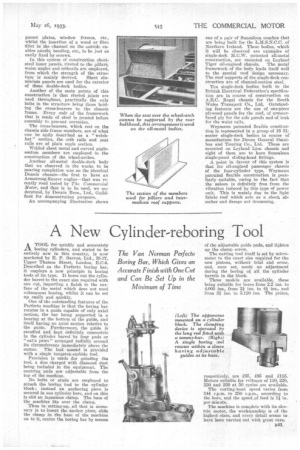Weymann's Coachbuilding Progress
Page 54

Page 55

If you've noticed an error in this article please click here to report it so we can fix it.
Points of Interest in the Various Types of Body Now Being Turned Out at the Concern's Addlestone Factory. All-metal, Timber and Flexible Construction Employed
EARLY in the year, Weyroann's Motor Bodies (1925), Ltd., Addlestone, Surrey, completed the enlargement of its premises and the installation of special machinery, and in addition to its previous activities, commenced the manufacture of the M.C.W. all-metal body—the special structure hitherto made only by its associated company, the Metropolitan C,ammell Carriage, Wagon and Finance Co., Ltd., Birmingham. On the occasion of a re,cent visit to the works of the former concern, we found much activity prevailing.
Of the numerous jobs in hand there were four interesting 56-seater doubledeck buses for the Western Welsh Omnibus Co., Ltd., one of which is shown in an accompanying illustration. The chassis are A.E.C. Renown six-wheelers and the bodies, which are coachbuilt, possess several unusual features.
As can be seen, they have sliding doors at the front near sides with special staircases incorporating " two-way " landings to the upper saloons. On the Ripper deck the front seat, which has nccommodation for three passengers, is placed in front of the stairway. In both saloons all seats face forward. The doors and windows are Bedawat pro
ducts, whilst ventilation is afforded by Ashanco devices. Being intended for long-distance work, these vehicles are provided with ample luggage accommodation. Under the stairs of each bus special racks are placed, the parcel containers at the sides of the lower deck are exceptionally commodious, and platforms, railed off to carry further luggage, are built ever the wheel-arches.
Two other batches of double-deck bodies we observed in the shops were five 52-seaters on A.E.G. Regent chassis for the City of Oxford Motor Services, Ltd., and five coachbuilt bodies for Sunbeam six-wheeled trolley-bus chassis for Walsall Corporation, and we were informed that work had been in hand some time on the building of 12 double-deck bodies for Guy trolley-bus chassis to fulfil an order received from Derby Corporation.
For the _first-named of these three contracts the M.C.W. patented all-metal system of construction is being employed. The outstanding feature of this method is the design of the members used for all pillars, and for intermediate roof supports. They are of a special section formed from cold-drawn steel tube. The folds of the section are illustrated in an accompanying sketch, The design is a patent of the Birmingham concern.
It is clear that, whilst possessing immense strength, the shape of the member lends itself admirably for the attachment to it of other parts, such as gusset plates, window frames, etc., whilst the insertion of a wood or fibre fillet in the channel on the outside enables panels, beading, etc., to be just as easily fixed by screws.
In this system of construction sheetsteel inner panels, riveted to the pillars, waist angles and clibrails are employed, from which the strength of the struc
ture is mainly derived. Sheet aluminium panels are used for the exterior of these double-deck bodies.
Another of the main points of this construction is that riveted joints are used throughout, practically the only bolts in the structure being those holding the cross-bearers to the chassis frame. Every unit of the framework that is made of steel is treated before assembly to prevent corrosion.
The cross-bearers, which rest on the chassis side frame members, are of what can be aptly described as a " welshhat " section, the crib rails and seat rails are of plain angle section.
Welded sheet metal and curved anglesection members are employed in the construction of the wheel-arches.
Another all-metal double-deck body that we observed in the works to be nearing completion was on the identical Dennis chassis—the first to have an Armstrong-Saurer engine—that was recently road tested by The Commercial Motor, and that is to be used, we understand, by Dennis Bros., Ltd., Guildford for demonstration purposes.
An accompanying illustration shows
one of a pair of Sunsaloon coaches that are being built for the L.M.S.N.C.C. of Northern Ireland. These bodies, which it will be observed are examples of single-deck M.C.W. patented all-metal construction, are mounted on Leyland
Tiger oil-engined chassis. The metal framework of the body lends itself well to the special roof design necessary. The roof supports of the single-deck construction are of channel-section steel.
Ten single-deck bodies built to the British Electrical Federation's specification are in course of construction on A.E.C. Regal chassis for the South Wales Transport Co., Ltd. Outstanding features are the use of one-piece plywood panels for the roof, of armourfaced ply for the side panels and of teak for the waist rails.
Weymann patented flexible construction is represented in a group of 18 31seater single-deck bodies in course of manufacture for Devon General Omnibus and Touring Co., Ltd. These are mounted on Leyland Lion chassis and eight of them are to have Sunsaloon single-panel sliding-head fittings.
A point in favour of this system is that for oil-engined passenger chassis of the four-cylinder type, Weymann patented flexible construction is peculiarly suitable, owing to the fact that the saloon is deflnitely free from the vibration induced by this type of power unit. This is mainly due to the light fabric roof which acts as a shock absorber and damps out drumming.




























































































